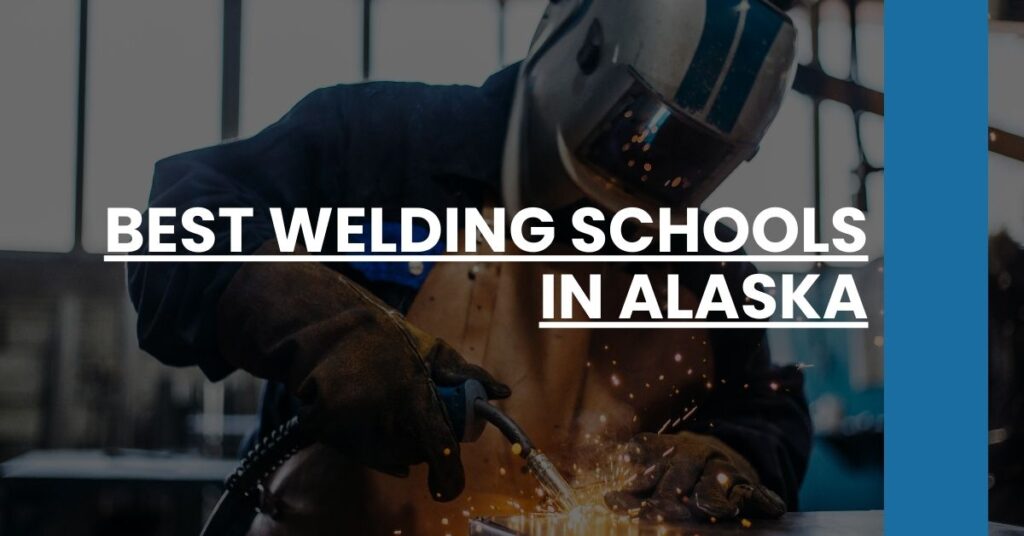Looking for schools in a specific city? Check out our lists of Welding Schools in Anchorage.
Finding the Best Welding Schools In Alaska can feel overwhelming, especially given the unique demands of the state’s industries.
You might be wondering which schools offer the best training, certifications, and job placements.
I’ve put together a comprehensive guide to help you navigate your options and find the right fit for your career goals.
In this guide, you’ll discover:
- A list of the best welding schools in Alaska
- Detailed program and certification information
- Insights on job opportunities and salary prospects after graduation
- Why Choose a Welding Career in Alaska?
- Top Welding Schools in Alaska
- Welding Programs Offered in Alaska
- How to Become a Certified Welder in Alaska
- Cost of Welding Schools in Alaska
- Welding Career Opportunities in Alaska
- Average Welder Salary in Alaska
- Welding Schools in Anchorage
- Alaska Welding FAQs
- Looking for Welding School Information On States Bordering Alaska?
- Conclusion
Why Choose a Welding Career in Alaska?
Employment Growth
Alaska’s welding industry is not only growing but is also projected to continue this trajectory. The Alaska Department of Labor and Workforce Development foresees a 14% growth in welding-related employment by 2030. This growth is largely due to extensive infrastructure needs. Projects like the Trans-Alaska Pipeline, shipyards, and power plants require skilled welders who can ensure safety and efficiency.
High Earning Potential
Your earning potential as a welder in Alaska is substantial. Statistics show that Alaska is the second top-paying state for welders. For instance, underwater welders in the state earn an average of $66,732 annually. Those with significant experience and specialized certifications can earn up to $114,947. This high earning potential makes welding an attractive career choice for many.
Diverse Work Environment
Alaska’s industries are diverse, including sectors like petroleum, construction, aviation, and maritime. As a welder, you’ll find job prospects in various settings, from pipeline maintenance to shipbuilding. This diversity not only provides ample job opportunities but also allows you to choose a work environment that best suits your skills and interests.
Top Welding Schools in Alaska
Several institutions in Alaska offer excellent welding programs. Here are some of the best options available to you:
AVTEC – Alaska Vocational Technical Center
Located in Seward, AVTEC offers a robust 38-week Industrial Welding program. This comprehensive training covers basic to advanced welding techniques. You’ll work with modern equipment and learn safety standards. By the end of the program, you can earn certifications like the AWS Unlimited Thickness Structural Certification and ASME Section IX, 6G Pipe Certification.
Kenai Peninsula College
Kenai Peninsula College offers a Welding Certificate Program in Soldotna. This one-year program provides comprehensive training in welding technologies. The tuition costs are approximately $235 per credit. This makes the program both thorough and affordable, giving you a solid foundation in welding.
Northern Industrial Training
With locations in Palmer and Anchorage, Northern Industrial Training offers various short-term programs. These include Structural Welding and Pipe Welding courses, with costs ranging between $9,000 and $10,000 depending on the specific program. These programs are designed to quickly get you up to speed and into the workforce.
University of Alaska Anchorage
The University of Alaska Anchorage offers an Advanced Welding Occupational Endorsement Certificate program. This one-year program costs around $7,000. It focuses on advanced welding techniques and provides hands-on training to prepare you for high-demand jobs.
University of Alaska Southeast
The University of Alaska Southeast has campuses in Juneau, Ketchikan, and Sitka. They offer programs that focus on general welding techniques and provide AWS and ASME certifications. With tuition averaging around $7,000, these programs are both comprehensive and cost-effective.
Welding Programs Offered in Alaska
Certificate Programs
Many institutions in Alaska offer certificate programs. For example, Kenai Peninsula College and the University of Alaska Southeast provide programs covering foundational skills in SMAW, GMAW, TIG, and FCAW welding techniques. These programs are designed to give you the essential skills needed for entry-level positions.
Diploma Programs
Northern Industrial Training offers diploma courses in Structural and Pipe Welding. These programs include training based on the NCCER curriculum and provide hands-on experience. You’ll graduate with the skills needed for more specialized welding roles.
Associate Degrees
Some institutions, like the University of Alaska Anchorage, offer more in-depth programs. These programs include advanced welding skills, structural design, and OSHA safety procedures. An associate degree can open doors to higher-paying and more specialized job opportunities.
How to Become a Certified Welder in Alaska
Complete High School
Most welding programs require that you have a high school diploma or equivalent. High school courses in mathematics, shop, and science can be particularly beneficial.
Enroll in a Welding Program
You need to enroll in a welding program to gain the necessary skills. Institutions like AVTEC and Northern Industrial Training offer programs specifically designed to prepare you for certification.
Gain Hands-On Experience
On-the-job training is crucial. Apprenticeships or entry-level jobs provide hands-on experience and can make you more competitive in the job market.
Get Certified
Certifications are essential for a welding career. You need to pass relevant exams from bodies like AWS and ASME. Common certifications include the AWS Unlimited Thickness Structural Certification and ASME Section IX, 6G Pipe Certification. These certifications validate your skills and enhance your employment prospects.
Cost of Welding Schools in Alaska
Tuition Costs
The cost of welding programs varies. For example, AVTEC’s Industrial Welding program costs around $25,000. Tuition at Kenai Peninsula College is approximately $235 per credit. Northern Industrial Training programs range between $9,000 and $23,000. Each program’s cost reflects the depth and duration of the training provided.
Financial Aid
Most institutions accept various forms of financial aid. For instance, AVTEC accepts Federal Financial Aid, scholarships, and funding from sources like WIOA grants and veterans’ benefits. You should fill out the FAFSA to determine your eligibility for Pell Grants and loans. Financial aid can significantly reduce the out-of-pocket costs of your education, making it more accessible.
Additional Costs
Apart from tuition, you may incur additional costs like materials, books, and certification exam fees. These expenses are usually modest but should be factored into your financial planning. Some schools offer financial assistance for these additional costs, so it’s worth inquiring about these options when you apply.
Welding Career Opportunities in Alaska
Industry Demand
The demand for skilled welders in Alaska spans multiple industries. This diversity provides numerous job opportunities, ensuring you can find a niche that best suits your skills and interests.
- Oil and Gas Sector: The oil and gas industry, including pipeline maintenance for the Trans-Alaska Pipeline System, requires expert welders. This sector offers high job security and competitive wages.
- Construction: As Alaska continues to develop its infrastructure, the construction industry constantly needs skilled welders for building projects, bridges, and roadways.
- Maritime Industry: Shipbuilding and repair are integral to Alaska’s economy. Welders in this industry find work in docks and shipyards, ensuring vessels are seaworthy and up to safety standards.
Potential Employers
Several key employers consistently seek qualified welders, offering stable and well-paying jobs:
- Bay Welding Services: Located in Homer, Bay Welding Services is a significant employer in the maritime welding sector. They offer positions in fabrication, construction, and repair of nautical vessels.
- Iron Workers Local #751: This organization provides opportunities through its Mobile Welding Program. It highlights community-oriented jobs and infrastructure projects across the state.
- Contract and Temporary Opportunities: Many welders find lucrative short-term projects through contract work, especially in rural areas where construction and industrial needs are high.
Growth Sectors
The ongoing development projects in both urban and rural regions mean that the demand for skilled welders remains high. Rural areas are expanding their infrastructure, thus requiring more specialized welding services. This expansion translates into job security and numerous opportunities for career advancement.
Average Welder Salary in Alaska
Competitive Earnings
Welders in Alaska earn competitive salaries, making the career path both financially rewarding and stable.
- State-Wide Average: As of 2024, the average salary for a welder in Alaska is $63,006 per year. This figure includes various welding specialties and experience levels.
- Range of Pay: Salaries typically range from $56,034 to $71,958. This variation depends on factors such as job location, industry, and level of experience.
Specialized Roles
Specialized welding roles offer even higher pay:
- Underwater Welders: These professionals earn significantly more due to the complexity and risk of their work. Salaries can reach as high as $114,947 for the most experienced underwater welders.
- Pipe Welders: Welders specializing in pipe welding often find high-paying jobs in the oil and gas sector, which values precision and expertise.
Factors Influencing Pay
Several factors influence welding salaries in Alaska. Experience and certifications play crucial roles. Industry demand and specific job roles also affect earning potential. For example, welders working on critical infrastructure projects or in remote locations may command higher wages due to the challenging nature of the work.
Welding Schools in Anchorage
Charter College
Charter College in Anchorage offers a fast-track welding program. You can complete this program in less than a year, making it an excellent option if you’re eager to enter the workforce quickly. Tuition ranges from $17,208 to $26,712. The program focuses on hands-on training in SMAW and GMAW.
Northern Industrial Training
Northern Industrial Training also provides welding education in Anchorage. Their courses cover various welding disciplines, including Structural, Pipe, and Fabrication Welding. Tuition costs range from $450 to $23,000, depending on the program’s length and depth.
University of Alaska Anchorage
The University of Alaska Anchorage stands out with its Advanced Welding Occupational Endorsement Certificate program. This one-year program costs around $7,000 and offers advanced training and hands-on experience. It is ideal for those looking to specialize and advance their careers.
Alaska Welding FAQs
What are the Certification Requirements?
To become a certified welder in Alaska, you need to complete accredited training programs and pass certification exams. These certifications are issued by recognized bodies such as AWS (American Welding Society) and ASME (American Society of Mechanical Engineers).
What Financial Aid Options Are Available?
There are multiple sources of financial aid available to aspiring welders. Federal financial aid can be accessed through FAFSA. Many schools offer state-specific grants and scholarships. Additionally, some technical schools provide financial assistance directly related to their programs. Veterans’ benefits and WIOA (Workforce Innovation and Opportunity Act) grants are also commonly available.
What Are the Job Prospects Post-Graduation?
Job prospects for welders in Alaska are strong. The diverse industries in the state ensure a high demand for skilled welders. With higher-than-average salaries and a growing employment rate, welding is a secure and lucrative career choice.
Looking for more Welder information? Check out our Certified Welding Inspector (CWI) practice test, find welding schools near you, learn how to become a welder, and explore options for welder certification.
Looking for Welding School Information On States Bordering Alaska?
In addition to Alaska, we suggest looking for schools in nearby states.
- Best Welding Schools In Washington
- Best Welding Schools In Oregon
- Best Welding Schools In California
- Best Welding Schools In Hawaii
- Best Welding Schools In Idaho
Conclusion
Embarking on a welding career in Alaska offers numerous benefits, from competitive salaries and job stability to diverse work environments. The best welding schools in Alaska provide comprehensive training programs, ensuring you will be well-prepared for certification and employment. Financial aid options make these programs accessible. With a strong demand for skilled welders across multiple industries, you can look forward to a rewarding career in the Last Frontier.
For more information and to start your journey, refer to the summary of key points on welding career.

